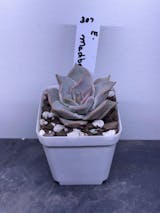About Echeveria Madiba
Echeveria Madiba is a succulent of the Echeveria genus in the Crassulacea family. It is a hybrid succulent bred by Korean gardeners. Echeveria Madiba belongs to the medium to large-sized Echeveria genus. It has a typical rosette form and may not appear particularly impressive at first glance. During the early stages of growth, the plant does not exhibit prominent curling or wrinkling of the leaves. The leaves of it are elongated spoon-shaped, tapering sharply at the tips. They have a light white farina coating on the surface and are predominantly gray-white. The leaves gradually become reddish when the plant is healthy and well-colored. Older leaves develop wavy wrinkles along the edges, while new leaves are lacy.
How to care for Echeveria Madiba
Sun: Sufficient light must be maintained during the growth of Echeveria Madiba succulents. Under the action of sunlight, it can promote photosynthesis and synthesize nutrients to promote growth. Echeveria Madiba can be placed in a brightly lit place or directly placed outdoors for cultivation, making the succulent plants stronger and the leaves more colorful and beautiful. Echeveria Madiba cannot withstand strong sunlight, so you should pay attention to proper shading in summer and avoid direct sunlight.
Temperature: This variety is a spring and autumn type and prefers a sunny and warm, dry environment. The optimal temperature range for its growth is between 50-86°F. It should be provided with partial shade during hot summer and well-ventilated. In winter, it should be protected from temperatures below 30°F. Echeveria Agavoides 'Gazelle' is a delicate succulent variety that requires indoor protection during the winter months to ensure its survival. E. 'Madiba' can withstand temperatures as low as 30 °F. USDA Plant Hardiness Zones 10a to 11b, 30 to 50 °F.
Soil: Echeveria Madiba is suitable for growing in sandy soil with loose soil, deep soil and rich organic matter. Suitable soil can facilitate root development and growth. When preparing the soil, a small amount of particulate matter can be properly mixed in(a particle ratio of around 70% is sufficient), and the potting soil should be replaced every 1-2 years and raised in suitable new soil.
Watering: Echeveria Madiba is a drought-tolerant succulent, so letting the soil completely dry between watering is essential. Let the soil completely dry before watering the Echeveria Madiba. Typically, this means watering every 7-10 days during the growing season (spring and summer) and reducing the frequency during the dormant season (fall and winter) to once every 2-3 weeks. When watering, using the "soak and dry" method is best. This means thoroughly watering the soil until water drains out of the bottom of the pot. Ensure the excess water drains completely to avoid waterlogging the roots.
Propagation: Like all Echeveria succulents, Echeveria Madiba is usually propagated from leaves. Spring is the best time to take leaves. To propagate Echeveria Madiba, gently remove a healthy leaf and let it callus for a few days. Prepare well-draining soil and bury the calloused end of the leaf. Mist the soil lightly and place the container in a bright location. After a few weeks, new rosettes or roots will form. Once established, transplant them to individual pots or suitable areas.
More information
Primary color: Green, grey, white
Secondary color: Red, white
Cold hardiness: USDA zones 10a-11b
Product format: rooted in 2" nursery pot.
Suitability: balcony, window
Propagation: leaf




